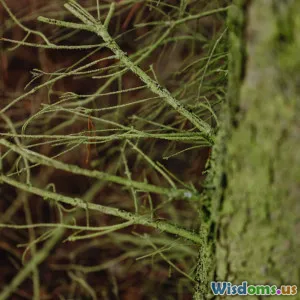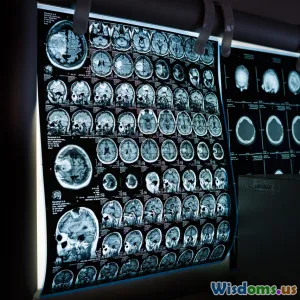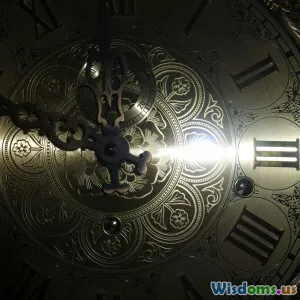
Five Surprising Ways Fractals Show Up in Your Everyday Life
9 min read Discover five unexpected ways fractals manifest around us daily, revealing the hidden patterns shaping nature, technology, and our own bodies. (0 Reviews)
Five Surprising Ways Fractals Show Up in Your Everyday Life
Fractals might bring to mind complex mathematical equations or the self-replicating shapes studied in advanced geometry classes, but they are far more relatable and relevant than you might realize. These infinitely complex patterns — repeating at every scale — embody a surprising principle that lives at the intersection of nature, art, and technology.
If you’ve ever marveled at the fern’s leaves, the rugged coastlines visible from a plane, or even the branching network of veins in your hand, you’ve encountered fractals. But these natural phenomena only scratch the surface. Let’s dive into five astonishing examples of how fractals sneak into your everyday life and how understanding them can enrich your perspective.
1. Nature’s Blueprint: Plants and Trees Reflect Fractals
The most visually arresting fractals happen often in nature — and trees and plants are causes en vogue.
The branching structure of many trees follows fractal patterns. When you zoom into a full tree canopy, you’ll see limbs splitting into smaller branches; those limbs then bifurcate repeatedly down to the twigs and ultimately leaves. This recursive pattern optimizes space, sunlight capture, and nutrient circulation.
Example: Romanesco Broccoli
Romanesco broccoli is a concrete example of a fractal design in nature’s pantry. Each bud is composed of a series of mini spiraled cones that replicate the shape of the whole vegetable, consistently scaling down while maintaining the same fractal form. This natural geometry is not just beautiful but reflects a highly efficient growth pattern.
Why It Matters
Understanding how plants grow fractally doesn’t just satisfy intellectual curiosity; it inspired scientists and architects designing bio-mimetic structures. Fractal geometry allows maximizing exposure and strength while minimizing material — seen in advancements from solar panel arrays mimicking leaf patterns to urban green designs.
2. The Human Body: Fractals in Our Framing and Function
Fractals are embedded inside us too. The human body’s architecture and even some physiological processes follow fractal patterns.
Our Lungs: A Fractal Air Supply
The branching bronchial tubes in lungs exemplify fractal geometry. Starting from the trachea, airways subdivide to maximize the surface area available for gas exchange with a compact volume. This fractal network increases efficiency significantly — the lung’s internal surface area rivals that of a tennis court despite the small organ size.
Vascular and Neural Networks
Our circulatory system also exhibits fractal branching. Arteries divide and taper in complex fractal patterns to deliver blood to every cell effectively. Similarly, the structural layout of the brain’s neural pathways, dendrites, and synapses mirror fractal networks — supporting complex processing within limited spaces.
A Real-World Insight
Research shows that fractal patterns in heartbeat variability correlate with good health. Deviations toward too regular or too chaotic rhythms can indicate disease. This knowledge is guiding doctors developing better diagnostics and monitoring tools.
3. Urban Planning and Architecture: Cities with Fractal Footprints
Fractals are not exclusively natural — human-designed environments often develop fractal characteristics, too. Cities, when observed from above or maps, exhibit fractal-like patterns in road networks, park systems, and buildings.
The Network Effect
Like tree branches or vascular systems, roads often branch hierarchically from highways into smaller streets and alleys. Such fractal layouts improve navigation and traffic flow. Some urban planners intentionally design fractal street frameworks to optimize accessibility and green space.
Architecture Inspired by Fractals
Architects study fractal geometry to create aesthetically pleasing and structurally sound buildings. Frank Lloyd Wright famously incorporated fractal patterns into his designs, providing harmony between repeated design units and the organic forms of nature.
Example: Barcelona’s Street Grid
Barcelona's famous Eixample district with its block chamfered corners hints at fractal-like modular iteration, combining functionality and beauty over scaled units.
4. The Internet and Technology: Fractals Shape Virtual Landscapes
Zoom into the digital realm, and fractals emerge in network design, user interfaces, and algorithmic processes.
Network Topologies
Internet and telecommunications networks resemble fractal branching where main servers connect to sub-networks and then to end-users in hierarchical layers. This fractalized distribution improves data delivery efficiency and scalability.
Image Compression and Fractal Algorithms
Fractal compression techniques exploit self-similarity in images to reduce file size without sacrificing quality. The technology, used in some image and video formats, identifies repeating patterns at different scales, akin to fractal math.
Video Games and Fractal Worlds
Many virtual landscapes in gaming use fractal algorithms to generate realistic terrains: mountains, clouds, coastlines, and forests, bringing immersive randomness balanced with mathematical order.
5. Financial Markets and Weather Patterns: Fractals in Systems and Forecasts
The idea that fractals extend beyond static forms to dynamic systems can be surprising.
Stock Market Fluctuations
Mathematician Benoit Mandelbrot, the father of fractal theory, analyzed financial market data and discovered fractal patterns in price changes. Market variations don’t follow smooth lines but jagged, self-similar fluctuations that appear consistent across different time scales.
This insight challenges classical economics and inspires better risk assessment models.
Weather and Climate
Meteorological phenomena like cloud formations, rainfall distributions, and atmospheric turbulence exhibit fractal behavior. Recognizing fractal dynamics in weather helps improve the modeling and predictability of complex climate systems.
Practical Application: Disaster Prediction
Fractal geometry aids in forecasting natural hazards like wildfires or floods by describing the irregular but patterned behaviors in environmental data, enhancing preparedness.
Conclusion
Fractals are far from abstract mathematical curiosities; they are a profound principle weaving complexity and simplicity into the fabric of reality. From the spirals of a vegetable to the branching in your lungs, from the layout of your city streets to the digital networks enabling our communications, fractals shape everyday life in remarkable ways.
Recognizing these patterns helps us appreciate the harmony in the world around us and inspires innovations that respect nature’s efficiency. Next time you look at a leaf, stroll through a park, or browse a website, remember — a fractal story lies beneath those patterns, whispering timeless connectivity amidst apparent chaos.
Understanding fractals not only enlightens us about the beauty of complexity; it equips us to design better technologies, healthier cities, and sustainable nature-inspired futures.
The fractal lens invites exploration, creativity, and awe — making the ordinary extraordinary.
References:
- Mandelbrot, B. B. (1983). The Fractal Geometry of Nature. W. H. Freeman and Co.
- West, G. B., Brown, J. H., & Enquist, B. J. (1997). A general model for the origin of allometric scaling laws in biology. Science, 276(5309), 122-126.
- National Institutes of Health. Fractals in the human body. (https://www.nih.gov/)
- Salingaros, N. A. (2006). A theory of architecture. Journal of Architectural and Planning Research.
- Peitgen, H.-O., Jürgens, H., & Saupe, D. (2004). Chaos and Fractals: New Frontiers of Science. Springer.
Rate the Post
User Reviews
Popular Posts


















